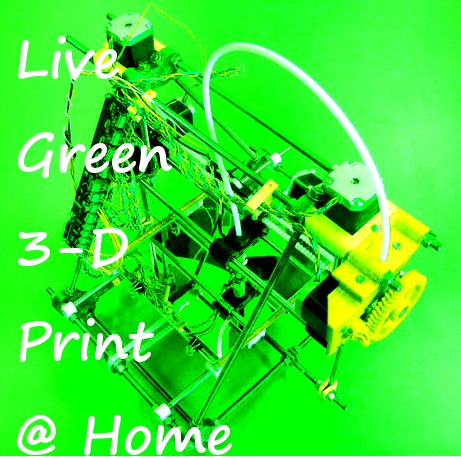J.M.Pearce (talk | contribs) m (Created page with "{{MOST}}{{MOST-RepRap}} right == Source== Megan Kreiger and Joshua M. Pearce (2013). [http://pubs.acs.org/doi/abs/10.1021/sc400093k Environmental L...") |
J.M.Pearce (talk | contribs) mNo edit summary |
||
| Line 6: | Line 6: | ||
==Abstract== | ==Abstract== | ||
With the recent development of the [[RepRap]], an [[open-source]] self-replicating rapid prototyper, low-cost [[3-D printing]] is now a technically viable form of [[distributed manufacturing]] of polymer-based products. However, the aggregate [[environmental benefits]] of distributed manufacturing are not clear due to scale reductions and the potential for increases in embodied energy. To quantify the environmental impact of distributed manufacturing using 3-D printers, a life cycle analysis was performed on three plastic products. The embodied energy and emissions from conventional large-scale production in low-labor cost countries and shipping are compared to experimental measurements on a RepRap with and without [[solar photovoltaic]] (PV) power fabricating products with [[acrylonitrile butadiene styrene]] (ABS) and [[polylactic acid]] (PLA). The results indicate that the cumulative energy demand of manufacturing polymer products can be reduced by 41-64% (55-74% with PV) and concomitant emission reductions using distributed manufacturing with existing low-cost open-source 3-D printers when using <25% fill PLA. Less pronounced positive environmental results are observed with ABS, which demands higher temperatures for the print bed and extruder. Overall, the results indicate that distributed manufacturing using open-source 3-D printers has the potential to have a lower environmental impact than conventional manufacturing for a variety of products. | With the recent development of the [[RepRap]], an [[open-source]] self-replicating rapid prototyper, low-cost [[3-D printing]] is now a technically viable form of [[distributed manufacturing]] of polymer-based products. However, the aggregate [[environmental benefits]] of distributed manufacturing are not clear due to scale reductions and the potential for increases in embodied energy. To quantify the environmental impact of distributed manufacturing using 3-D printers, a life cycle analysis was performed on three plastic products. The embodied energy and emissions from conventional large-scale production in low-labor cost countries and shipping are compared to experimental measurements on a RepRap with and without [[solar photovoltaic]] (PV) power fabricating products with [[acrylonitrile butadiene styrene]] (ABS) and [[polylactic acid]] (PLA). The results indicate that the cumulative energy demand of manufacturing polymer products can be reduced by 41-64% (55-74% with PV) and concomitant emission reductions using distributed manufacturing with existing low-cost open-source 3-D printers when using <25% fill PLA. Less pronounced positive environmental results are observed with ABS, which demands higher temperatures for the print bed and extruder. Overall, the results indicate that distributed manufacturing using open-source 3-D printers has the potential to have a lower environmental impact than conventional manufacturing for a variety of products. | ||
==See Also== | |||
* [[Environmental impacts of distributed manufacturing from 3-D printing of polymer components and products]] - A preliminary study presented at the MRS | |||
===Method=== | |||
* [[Life cycle analysis: MOST]] | |||
* [[RepRap printing protocol: MOST]] | |||
[[Category:MOST completed projects and publications]] | [[Category:MOST completed projects and publications]] | ||
Revision as of 01:15, 28 September 2013

Source
Megan Kreiger and Joshua M. Pearce (2013). Environmental Life Cycle Analysis of Distributed 3-D Printing and Conventional Manufacturing of Polymer Products, ACS Sustainable Chemistry & Engineering, Just Accepted Manuscript. DOI: 10.1021/sc400093k [Open access]
Abstract
With the recent development of the RepRap, an open-source self-replicating rapid prototyper, low-cost 3-D printing is now a technically viable form of distributed manufacturing of polymer-based products. However, the aggregate environmental benefits of distributed manufacturing are not clear due to scale reductions and the potential for increases in embodied energy. To quantify the environmental impact of distributed manufacturing using 3-D printers, a life cycle analysis was performed on three plastic products. The embodied energy and emissions from conventional large-scale production in low-labor cost countries and shipping are compared to experimental measurements on a RepRap with and without solar photovoltaic (PV) power fabricating products with acrylonitrile butadiene styrene (ABS) and polylactic acid (PLA). The results indicate that the cumulative energy demand of manufacturing polymer products can be reduced by 41-64% (55-74% with PV) and concomitant emission reductions using distributed manufacturing with existing low-cost open-source 3-D printers when using <25% fill PLA. Less pronounced positive environmental results are observed with ABS, which demands higher temperatures for the print bed and extruder. Overall, the results indicate that distributed manufacturing using open-source 3-D printers has the potential to have a lower environmental impact than conventional manufacturing for a variety of products.
See Also
- Environmental impacts of distributed manufacturing from 3-D printing of polymer components and products - A preliminary study presented at the MRS

